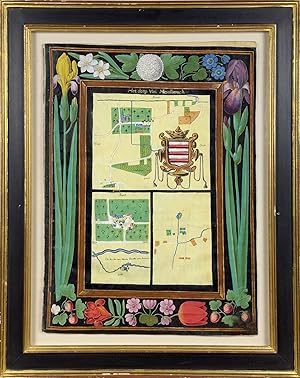Les Albums Croy, First Edition (2 results)
Product Type
- All Product Types
- Books (1)
- Magazines & Periodicals
- Comics
- Sheet Music
- Art, Prints & Posters
- Photographs
- Maps
-
Manuscripts &
Paper Collectibles (1)
Condition
- All Conditions
- New
- Used
Binding
Collectible Attributes
- First Edition
- Signed
- Dust Jacket (1)
- Seller-Supplied Images (1)
- Not Printed On Demand
Free Shipping
Seller Location
Seller Rating
-
Les Albums de Croy
Published by Societé Royale des Bibliophiles et Iconophiles de Belgique, Bruxelles, 1979
Book First Edition
Soft cover. Condition: Fine. Dust Jacket Condition: Fine. 1st Edition. Les Albums de Croy cataloog van de tentoonstelling in de Koninklijke Albert I bibliotheek in 1979 245 x 160 mm, 57 blz soft cover 173 blz met talrijke foto's in kleur en z/w 300 x 230 mm, soft cover.
-
Folium from the Album d'Authal of Charles de Cro’, with painted views of, inter alia, "Het dorp Van Meselbrouck" (recto) and "Het dorp Van Rillart" (verso)
Publication Date: 1596
Seller: Arader Books, New York, NY, U.S.A.
Manuscript / Paper Collectible First Edition
No binding. Condition: Very good. First. LATE-RENAISSANCE PAINTED VIEWS OF BELGIUM ON VELLUM, FROM A DOCUMENTARY PROJECT WITHOUT RIVAL. Ca. 1596-1598. Gouache, gilt and silver gilt on vellum (sheet: 20 3/4" x 14 7/8", 526mm x 383mm; frame: 26" x 21"). With some flaking and craquelure of the pigment. Vellum a little cockled, as usual. Framed floating in UVIII plexiglass recto and verso. Charles III de Cro’ (1560-1612), 4th Duke of Aarschot, 5th Prince of Chimay and 5th Count of Beaumont, was the scion of one of the great German noble families. Charles III's great grand-uncle was William II de Cro’, tutor to the future Holy Roman Emperor Charles V, and eventually his greatest councillor. Through him the family gained extraordinary wealth from the revenues of New Spain, as well as extensive properties throughout the Spanish Netherlands and environs: Hainault, Flanders and Brabant, Namur, Artois and Picardie. Consolidated over generations, the Cro’ lands increased not just agnatically but enatically. By 1590, his survey of his vast scattered real estate holdings came to be illustrated by the surveys -- a cadaster -- of Pierre de Bersacques. This vast array of views, plans and maps he gave to Adrien de Montigny (d. 1615) to turn into a series of sumptuous albums on vellum -- the most luxurious substrate for book-production and natural-history painting -- with heraldic, floral, figural and otherwise decorative borders. These "Albums de Cro’" are a singular document of late-Renaissance Europe, as much a record as an ostentation. From 1596-1611 some 2,500 views came to fill 23 volumes; the project expanded from Cro’ properties to broader areas of the family's influence. The Album d'Authal passed from Charles III de Cro’ to his wife Dorothea, and thence by descent to his nephew Alexandre d'Arenberg (Charles himself was childless), and from him ultimately to Ludmilla d'Arenberg (1870-1953) and then to her son Engelbert Ernst de Cro’ (1891-1974), who lived at Authal in Austria; purchased at Sotheby's London 19 June 2001, lot 47 (£1,213,500). The present leaf, unnumbered, illustrates four villages (dorpen), combinining steep views for buildings and trees, and bird's-eye plans for the locations of rivers, roads and parcels. Of these seven plans, six (excluding the bottom-right of the recto) are labeled with cardinal directions (three with North at top, two with South, one with East). There are numbers in most plans, which doubtless corresponded to a key; there was, however, no text included with the album when purchased. The largest plan on the sheet depicts Messelbroek (in modern Flemish Brabant in Belgium) on the recto in the upper section, with the church of St.-Michel, still standing. Another plan of "Het dorp Van Messelbrouck" -- all captions are gilt -- is at bottom-right of the verso. At the bottom-right of the recto, unlabeled, is the town of Gossoncourt (Goetsenhoven in Dutch), now a neighborhood of Tienen in Flemish Brabant. The remaining two villages are within the municipality of Aarschot (like the others on the sheet in Flemish Brabant) which was de Cro’'s ducal domain. On the recto: Gelrode (captioned "ghelroy") with the (now-demolished) church of Weerde in Langdorp (about 3 1/2 miles northeast) included due to a copying error, in the lower-left. On the verso are three plans of Rillaar (Rillaer in French; "Het dorp Van Rillart" in the captions): at top-left, the church of Rillaar with its commons; at bottom-left and top-right two additional views of the village. The borders of each page are of no lesser importance than the plans. On the recto is a black border set with flowers: yellow and purple iris along the sides, daffodils, wild strawberries, tulips and perhaps a white dahlia at top-center. Verso is a fantastical Mannerist composition on a black background, with botanical elements (tulips, irises, lilies, a fruit), figural elements (long-necked leopards at the lower corners) and polychrome strapwork with the Cro’ arms at upper center, surrounded in scrollwork.



